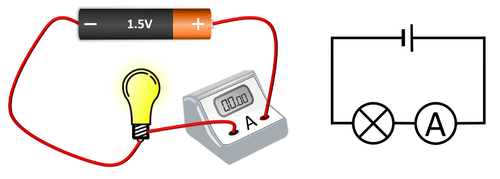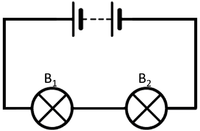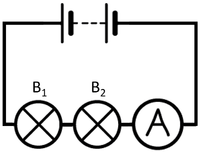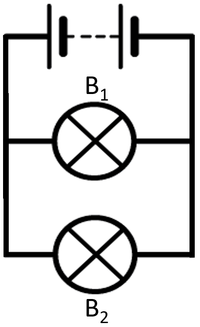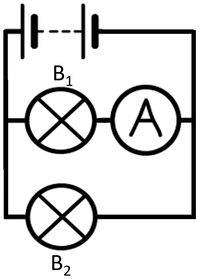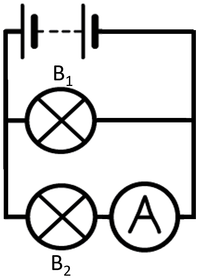Difference between revisions of "Ammeter"
| (8 intermediate revisions by one other user not shown) | |||
| Line 5: | Line 5: | ||
===About Ammeters=== | ===About Ammeters=== | ||
| − | : [[Ammeter]]s are added in [[series]] to a [[circuit]] to find the [[Electrical Current|current]] flowing through the [[circuit]]. | + | : [[Ammeter]]s are added in [[Series Circuit|series]] to a [[circuit]] to find the [[Electrical Current|current]] flowing through the [[circuit]]. |
: An ideal [[ammeter]] has zero [[Electrical Resistance|resistance]] because otherwise adding an [[ammeter]] to a [[circuit]] would change the [[Electrical Current|current]]. | : An ideal [[ammeter]] has zero [[Electrical Resistance|resistance]] because otherwise adding an [[ammeter]] to a [[circuit]] would change the [[Electrical Current|current]]. | ||
: [[Ammeter]]s can be [[Analogue Ammeter|analogue]] with a needle pointing to numbers on a dial or it can be [[Digital Ammeter|digital]] with a number display. | : [[Ammeter]]s can be [[Analogue Ammeter|analogue]] with a needle pointing to numbers on a dial or it can be [[Digital Ammeter|digital]] with a number display. | ||
| Line 14: | Line 14: | ||
| style="height:20px; width:200px; text-align:center;" |An '''ammeter''' placed in [[Series Circuit|series]] with a [[Electrical Bulb|bulb]]. | | style="height:20px; width:200px; text-align:center;" |An '''ammeter''' placed in [[Series Circuit|series]] with a [[Electrical Bulb|bulb]]. | ||
|} | |} | ||
| + | |||
| + | ==Key Stage 4== | ||
| + | ===Meaning=== | ||
| + | An [[ammeter]] is a measuring device used to [[measure]] [[Electrical Current|electrical current]]. | ||
| + | |||
| + | ===About Ammeters=== | ||
| + | : [[Ammeter]]s are added in [[Series Circuit|series]] to a [[circuit]] to find the [[Electrical Current|current]] flowing through the [[circuit]]. | ||
| + | : An ideal [[ammeter]] has zero [[Electrical Resistance|resistance]] because otherwise adding an [[ammeter]] to a [[circuit]] would change the [[Electrical Current|current]]. | ||
| + | : [[Ammeter]]s can be [[Analogue Ammeter|analogue]] with a needle pointing to numbers on a dial or it can be [[Digital Ammeter|digital]] with a number display. | ||
| + | |||
| + | {| class="wikitable" | ||
| + | |+Using an ammeter on components in series. | ||
| + | |- | ||
| + | |[[File:CircuitDiagramBatteryBulbBulbSeries.png|center|200px]] | ||
| + | |[[File:CircuitDiagramBatteryBulbBulbSeries.png|center|200px]] | ||
| + | |- | ||
| + | | style="height:20px; width:200px; text-align:center;" |To [[measure]] the [[Electrical Current|current]] through bulb 1 the [[ammeter]] can be placed anywhere in this [[Series Circuit|series circuit]]. | ||
| + | | style="height:20px; width:200px; text-align:center;" |To [[measure]] the [[Electrical Current|current]] through bulb 2 the [[ammeter]] can be placed anywhere in this [[Series Circuit|series circuit]]. | ||
| + | |- | ||
| + | |[[File:CircuitDiagramBatteryBulbBulbAmmeterSeries.png|center|200px]] | ||
| + | |[[File:CircuitDiagramBatteryBulbBulbAmmeterSeries.png|center|200px]] | ||
| + | |} | ||
| + | |||
| + | {| class="wikitable" | ||
| + | |+Using an ammeter on components in parallel. | ||
| + | |- | ||
| + | |[[File:CircuitDiagramBatteryBulbBulbParallel2.png|center|200px]] | ||
| + | |[[File:CircuitDiagramBatteryBulbBulbParallel2.png|center|200px]] | ||
| + | |- | ||
| + | | style="height:20px; width:200px; text-align:center;" |To [[measure]] the [[Electrical Current|current]] through bulb 1 the [[ammeter]] must be placed in [[Series Circuit|series]] with bulb 1. | ||
| + | | style="height:20px; width:200px; text-align:center;" |To [[measure]] the [[Electrical Current|current]] through bulb 2 the [[ammeter]] must be placed in [[Series Circuit|series]] with bulb 2. | ||
| + | |- | ||
| + | |[[File:CircuitDiagramBatteryBulbAmmeterBulbParallel.png|center|200px]] | ||
| + | |[[File:CircuitDiagramBatteryBulbBulbAmmeterParallel.png|center|200px]] | ||
| + | |} | ||
| + | |||
| + | ===References=== | ||
| + | ====AQA==== | ||
| + | :[https://www.amazon.co.uk/gp/product/0008158770/ref=as_li_tl?ie=UTF8&camp=1634&creative=6738&creativeASIN=0008158770&linkCode=as2&tag=nrjc-21&linkId=ec31595e720e1529e49876c3866fff6e ''Ammeter, pages 52-6, GCSE Physics; Student Book, Collins, AQA'] | ||
| + | :[https://www.amazon.co.uk/gp/product/1471851370/ref=as_li_tl?ie=UTF8&camp=1634&creative=6738&creativeASIN=1471851370&linkCode=as2&tag=nrjc-21&linkId=01c69b0ae058f809cf636033e6ba793e ''Ammeters, page 41, GCSE Physics, Hodder, AQA'] | ||
| + | :[https://www.amazon.co.uk/gp/product/019835939X/ref=as_li_tl?ie=UTF8&camp=1634&creative=6738&creativeASIN=019835939X&linkCode=as2&tag=nrjc-21&linkId=57e96876985fc39b1a3d8a3e3dc238b6 ''Ammeters, page 52, GCSE Physics; Third Edition, Oxford University Press, AQA'] | ||
| + | :[https://www.amazon.co.uk/gp/product/1782945598/ref=as_li_tl?ie=UTF8&camp=1634&creative=6738&creativeASIN=1782945598&linkCode=as2&tag=nrjc-21&linkId=ad276ad49df77ab4b40ab4fd0fe09675 ''Ammeters, pages 180, 239, GCSE Combined Science; The Revision Guide, CGP, AQA'] | ||
| + | :[https://www.amazon.co.uk/gp/product/178294558X/ref=as_li_tl?ie=UTF8&camp=1634&creative=6738&creativeASIN=178294558X&linkCode=as2&tag=nrjc-21&linkId=f0dfb66dafcb0c6e9449e7b1a4ae1ac15 ''Ammeters, pages 25, 106, GCSE Physics; The Revision Guide, CGP, AQA'] | ||
| + | :[https://www.amazon.co.uk/gp/product/1471851354/ref=as_li_tl?ie=UTF8&camp=1634&creative=6738&creativeASIN=1471851354&linkCode=as2&tag=nrjc-21&linkId=9012a0d354024419214fb3ad5ac44ba0 ''Ammeters, pages 293, 296, GCSE Combined Science Trilogy 1, Hodder, AQA'] | ||
| + | :[https://www.amazon.co.uk/gp/product/1782946403/ref=as_li_tl?ie=UTF8&camp=1634&creative=6738&creativeASIN=1782946403&linkCode=as2&tag=nrjc-21&linkId=32a0abb60dff015b15b50e9b1d7b4644 ''Ammeters, pages 60, 61, 235, GCSE Combined Science Trilogy; Physics, CGP, AQA'] | ||
| + | :[https://www.amazon.co.uk/gp/product/1782945970/ref=as_li_tl?ie=UTF8&camp=1634&creative=6738&creativeASIN=1782945970&linkCode=as2&tag=nrjc-21&linkId=a120d24dcc7cc7a58192069a3aafc1d2 ''Ammeters, pages 62, 63, 331, GCSE Physics; The Complete 9-1 Course for AQA, CGP, AQA'] | ||
| + | :[https://www.amazon.co.uk/gp/product/1471851370/ref=as_li_tl?ie=UTF8&camp=1634&creative=6738&creativeASIN=1471851370&linkCode=as2&tag=nrjc-21&linkId=01c69b0ae058f809cf636033e6ba793e ''Ammeters; circuit symbol, page 38, GCSE Physics, Hodder, AQA'] | ||
| + | ====Edexcel==== | ||
| + | :[https://www.amazon.co.uk/gp/product/1292120223/ref=as_li_tl?ie=UTF8&camp=1634&creative=6738&creativeASIN=1292120223&linkCode=as2&tag=nrjc-21&linkId=068ecf40278c32406a7f1c6e66751417 ''Ammeters, page 142, GCSE Physics, Pearson Edexcel ''] | ||
| + | :[https://www.amazon.co.uk/gp/product/1292120193/ref=as_li_tl?ie=UTF8&camp=1634&creative=6738&creativeASIN=1292120193&linkCode=as2&tag=nrjc-21&linkId=572df39392fb4200db8391d98ae6314e ''Ammeters, page 382, GCSE Combined Science, Pearson Edexcel ''] | ||
| + | :[https://www.amazon.co.uk/gp/product/1782945741/ref=as_li_tl?ie=UTF8&camp=1634&creative=6738&creativeASIN=1782945741&linkCode=as2&tag=nrjc-21&linkId=30da4f2178da182547b62a7329d13b57 ''Ammeters, pages 186, 210, GCSE Combined Science; The Revision Guide, CGP, Edexcel ''] | ||
| + | :[https://www.amazon.co.uk/gp/product/1782948163/ref=as_li_tl?ie=UTF8&camp=1634&creative=6738&creativeASIN=1782948163&linkCode=as2&tag=nrjc-21&linkId=0fdbfd5dd397d6e24a9dfb250f08587f ''Ammeters, pages 220, 338, GCSE Physics, CGP, Edexcel ''] | ||
| + | :[https://www.amazon.co.uk/gp/product/1782945733/ref=as_li_tl?ie=UTF8&camp=1634&creative=6738&creativeASIN=1782945733&linkCode=as2&tag=nrjc-21&linkId=2a2dbec9db6bf5766c0458d908fa0a52 ''Ammeters, pages 73, 106, GCSE Physics; The Revision Guide, CGP, Edexcel ''] | ||
| + | |||
| + | ====OCR==== | ||
| + | |||
| + | :[https://www.amazon.co.uk/gp/product/0198359837/ref=as_li_tl?ie=UTF8&camp=1634&creative=6738&creativeASIN=0198359837&linkCode=as2&tag=nrjc-21&linkId=3c4229e8b023b2b60768e7ea2307cc6f ''Ammeters, pages 102-103, 259, Gateway GCSE Physics, Oxford, OCR ''] | ||
| + | :[https://www.amazon.co.uk/gp/product/1782945695/ref=as_li_tl?ie=UTF8&camp=1634&creative=6738&creativeASIN=1782945695&linkCode=as2&tag=nrjc-21&linkId=ceafcc80bcad6b6754ee97a0c7ceea53 ''Ammeters, pages 178, 224, Gateway GCSE Combined Science; The Revision Guide, CGP, OCR ''] | ||
| + | :[https://www.amazon.co.uk/gp/product/1782945687/ref=as_li_tl?ie=UTF8&camp=1634&creative=6738&creativeASIN=1782945687&linkCode=as2&tag=nrjc-21&linkId=9a598e52189317a20311d7a632747bc9 ''Ammeters, pages 45, 49, 105, Gateway GCSE Physics; The Revision Guide, CGP, OCR ''] | ||
Latest revision as of 10:37, 30 November 2019
Contents
Key Stage 3
Meaning

A picture showing an analogue ammeter.
An ammeter is a measuring device used to measure electrical current.
About Ammeters
- Ammeters are added in series to a circuit to find the current flowing through the circuit.
- An ideal ammeter has zero resistance because otherwise adding an ammeter to a circuit would change the current.
- Ammeters can be analogue with a needle pointing to numbers on a dial or it can be digital with a number display.
| An ammeter placed in series with a bulb. |
Key Stage 4
Meaning
An ammeter is a measuring device used to measure electrical current.
About Ammeters
- Ammeters are added in series to a circuit to find the current flowing through the circuit.
- An ideal ammeter has zero resistance because otherwise adding an ammeter to a circuit would change the current.
- Ammeters can be analogue with a needle pointing to numbers on a dial or it can be digital with a number display.
| To measure the current through bulb 1 the ammeter can be placed anywhere in this series circuit. | To measure the current through bulb 2 the ammeter can be placed anywhere in this series circuit. |
| To measure the current through bulb 1 the ammeter must be placed in series with bulb 1. | To measure the current through bulb 2 the ammeter must be placed in series with bulb 2. |
References
AQA
- Ammeter, pages 52-6, GCSE Physics; Student Book, Collins, AQA'
- Ammeters, page 41, GCSE Physics, Hodder, AQA'
- Ammeters, page 52, GCSE Physics; Third Edition, Oxford University Press, AQA'
- Ammeters, pages 180, 239, GCSE Combined Science; The Revision Guide, CGP, AQA'
- Ammeters, pages 25, 106, GCSE Physics; The Revision Guide, CGP, AQA'
- Ammeters, pages 293, 296, GCSE Combined Science Trilogy 1, Hodder, AQA'
- Ammeters, pages 60, 61, 235, GCSE Combined Science Trilogy; Physics, CGP, AQA'
- Ammeters, pages 62, 63, 331, GCSE Physics; The Complete 9-1 Course for AQA, CGP, AQA'
- Ammeters; circuit symbol, page 38, GCSE Physics, Hodder, AQA'
Edexcel
- Ammeters, page 142, GCSE Physics, Pearson Edexcel
- Ammeters, page 382, GCSE Combined Science, Pearson Edexcel
- Ammeters, pages 186, 210, GCSE Combined Science; The Revision Guide, CGP, Edexcel
- Ammeters, pages 220, 338, GCSE Physics, CGP, Edexcel
- Ammeters, pages 73, 106, GCSE Physics; The Revision Guide, CGP, Edexcel
